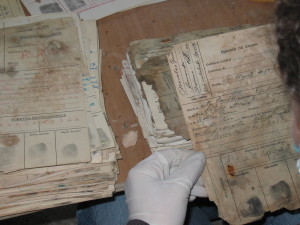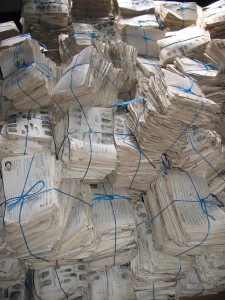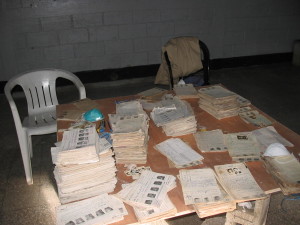The AHPN: Home of Stories Old and New
Access to the records contained in archives is a concern shared by many. Archives support memory and free access to them strengthens democratic processes. Everyone should be allowed to see first-hand the records contained in an archive and be free to interpret them as needed.
Access to archives can increase knowledge on various topics and opens opportunities for different fields of knowledge. The information available from archives can serve as a source of background material for making films or documentaries; it can be used to conduct research from the perspective of human rights; it can be used by archivists or statisticians to conduct research, either quantitative or qualitative.
An additional bonus to free and universal access to archival records is provided by modern technology, which can make the information secure and often can promise access from anywhere in the world.
However, not everything is as simple as black and white. Not everything is about the records themselves. Recently I had the pleasure of listening to a talk by Kirsten Weld, PhD, who wrote Paper Cadavers: The Archives of Dictatorship in Guatemala. The talk inspired me to write this note.
The AHPN (Historic Archive of the National Police), also referred to as the Archive, is more than just documents, sorted papers, or unknown stories. The Archive is a project about life, and the philosophy behind the project is a story in itself.
This research would not make sense, or rather, the statistical findings would be empty, if we failed to recognize the journey undertaken to arrive at where we are today.
Kirsten made me remember those first moments, when the idea of knowing and the thirst to find out motivated people and united our efforts in spite of the unfavorable conditions for the job. We sat as best we could, at a wooden board that was half-lit: that was our desk, and it was cluttered with laughter, jokes, and examples of brotherhood.
The Archive was an opportunity, an option for discovering another side of the story of our country, and of course, doing this work was accompanied by not very pleasant consequences. It was not always pleasant to move away a little from the present reality, to immerse ourselves in history, read, dream and relive the stories that we had to process every day, either by cleaning, organizing, sampling, or digitizing thousands of documents. This is a story that has not been understood fully, so some of the records opened wounds, or caused horror, anger, and frustration to some extent. But knowing we were building a generational bridge was enough incentive to not give up.
To initiate the work, we needed to have a general estimate of how much paper was contained in the Archive. Experts calculated that it contained about 80 million pages, or five miles of paper. That’s information covering many years, many stories, so much pain.
Nevertheless, thanks to the team of quantitative researchers, today we have a greater certainty about the universe of documents safeguarded in this incredible repository, i.e. about 46 million documents from the entire time period covered by the Archive. We will present this, and other results from the quantitative study in a full report coming soon.
Continuing the story, I bring to this a phrase shared by Kirsten in her talk, which identifies many of the feelings of those who have passed through the Historical Archives: “I do not know why I stay, and I know even less why I return,” referring to people who, under these circumstances, might have quit their work at the Archive.
Surely there are other archives, better organized, more comfortable and welcoming, she mentioned, but there are none like this one. The human warmth and commitment to history and Guatemala far outweigh any vicissitude, making it really easy to see that the experience is a walk through tears, sacrifices, renunciations and much learning.
We see ourselves as workers in the Archive. Some of us had to learn about and fall in love with the science of archives and statistics, which was not part of lives before 2006. But we had a need to do a good job and to have academic support and we wished to avoid bias or criticism, so we turned to outside voices to guide and teach us, so that today the result is much more tangible and appreciated from anywhere in the world.
Finally Kirsten mentioned something that continues to be true, that the users who are not connected to the historical archives or to the researchers themselves are most eager to access the information contained in the documents. Nevertheless, one of the lessons that I’ve been left with in this process is that other sciences provide us with, on one hand, reliability of the document, and on the other hand, information about the context of the document (the document is part of the collection).
I’ve learned that you must let the documents tell their story, and it is therefore important to know how their producers recorded the events. The analyses and interpretations will follow, but you should always know how the data, whether the word or category being studied, was constructed.
To conclude, I turn to the words of Martha Rodriguez from a talk in 2011, “The archives including management, research and memory,” (Los archivos entre la gestion, la investigacion, y la memoria) :
The archives are the result of organic and systematic production of documents from an institution in the exercise of their functions. This means that the documents themselves are born as a result of the activities of an institution. (…)
That is to say, the purpose that gives rise to documents is practical, administrative, legal, fiscal, but not historical or scientific. (…)[1]
THE AHPN SERIES by Carolina López
Quantitative Research at the AHPN Guatemala
The Story of One Document Inside the AHPN
The Art and Science of Coding AHPN Documents
Learning Day by Day: Quantitative Research at the AHPN
IRR: Agreement among Coders is Key
The AHPN: Home of Stories Old and New
The Great Lessons in Research at the Archive
Ten Years and Counting in Guatemala
The Case of Ana Lucrecia Orellana Stormont
All photos courtesy of AHPN.



